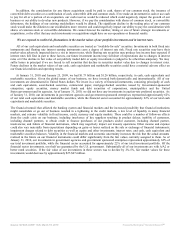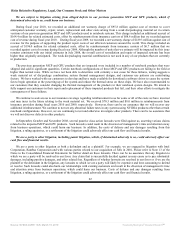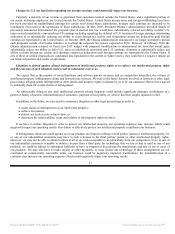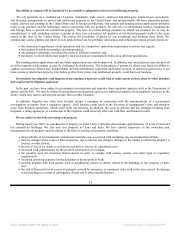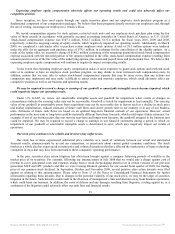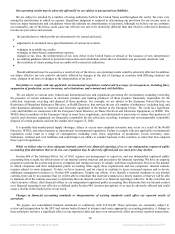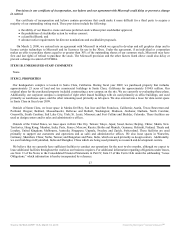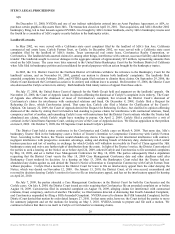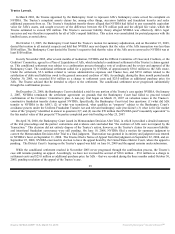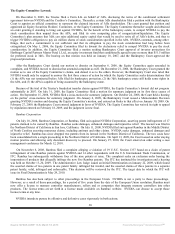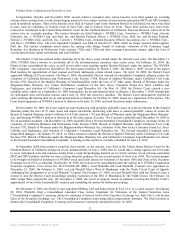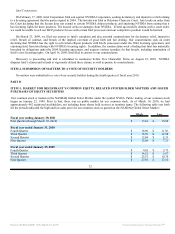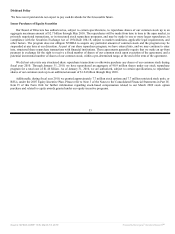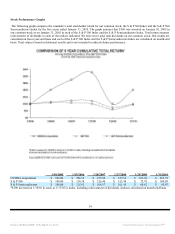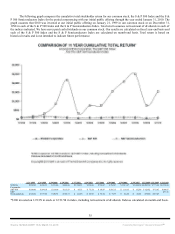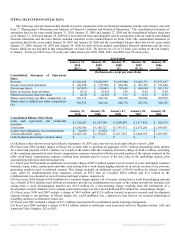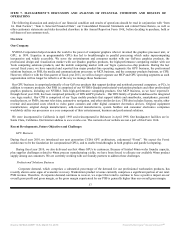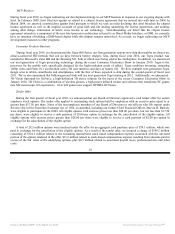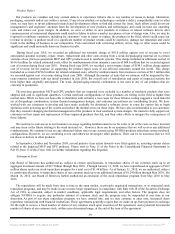NVIDIA 2010 Annual Report Download - page 43
Download and view the complete annual report
Please find page 43 of the 2010 NVIDIA annual report below. You can navigate through the pages in the report by either clicking on the pages listed below, or by using the keyword search tool below to find specific information within the annual report.
The Equity-Committee Lawsuit.
On December 8, 2005, the Trustee filed a Form 8-K on behalf of 3dfx, disclosing the terms of the conditional settlement
agreement between NVIDIA and the Creditor’s Committee. Thereafter, certain 3dfx shareholders filed a petition with the Bankruptcy
Court to appoint an official committee to represent the claimed interests of 3dfx shareholders. The court granted that petition and
appointed an Equity Securities Holders’ Committee, or the Equity Committee. The Equity Committee thereafter sought and obtained
an order granting it standing to bring suit against NVIDIA, for the benefit of the bankruptcy estate, to compel NVIDIA to pay the
stock consideration then unpaid from the APA, and filed its own competing plan of reorganization/liquidation. The Equity
Committee’s plan assumes that 3dfx can raise additional equity capital that would be used to retire all of 3dfx’s debts, and thus to
trigger NVIDIA’s obligation to pay six million shares of stock consideration specified in the APA. NVIDIA contends, among other
things, that such a commitment is not sufficient and that its obligation to pay the stock consideration had long before been
extinguished. On May 1, 2006, the Equity Committee filed its lawsuit for declaratory relief to compel NVIDIA to pay the stock
consideration. In addition, the Equity Committee filed a motion seeking Bankruptcy Court approval of investor protections for
Harbinger Capital Partners Master Fund I, Ltd., an equity investment fund that conditionally agreed to pay no more than $51.5 million
for preferred stock in 3dfx. The hearing on that motion was held on January 18, 2007, and the Bankruptcy Court approved the
proposed protections.
After the Bankruptcy Court denied our motion to dismiss on September 6, 2006, the Equity Committee again amended its
complaint, and NVIDIA moved to dismiss that amended complaint as well. On December 21, 2006, the Bankruptcy Court granted the
motion as to one of the Equity Committee’s claims, and denied it as to the others. However, the Bankruptcy Court also ruled that
NVIDIA would only be required to answer the first three causes of action by which the Equity Committee seeks determinations that
(1) the APA was not terminated before 3dfx filed for bankruptcy protection, (2) the 3dfx bankruptcy estate still holds some rights in
the APA, and (3) the APA is capable of being assumed by the bankruptcy estate.
Because of the trial of the Trustee’s fraudulent transfer claims against NVIDIA, the Equity Committee’s lawsuit did not progress
substantially in 2007. On July 31, 2008, the Equity Committee filed a motion for summary judgment on its first three causes of
action. On September 15, 2008, NVIDIA filed a cross-motion for summary judgment. On October 24, 2008, the Court held a hearing
on the parties’ cross-motions for summary judgment. On January 6, 2009, the Bankruptcy Court issued a Memorandum Decision
granting NVIDIA’s motion and denying the Equity Committee’s motion, and entered an Order to that effect on January 30, 2009. On
February 27, 2009, the Bankruptcy Court entered judgment in favor of NVIDIA. The Equity Committee has waived its right to appeal
by stipulation entered on February 18, 2009, and the judgment is now final.
Rambus Corporation
On July 10, 2008, Rambus Corporation, or Rambus, filed suit against NVIDIA Corporation, asserting patent infringement of 17
patents claimed to be owned by Rambus. Rambus seeks damages, enhanced damages and injunctive relief. The lawsuit was filed in
the Northern District of California in San Jose, California. On July 11, 2008, NVIDIA filed suit against Rambus in the Middle District
of North Carolina asserting numerous claims, including antitrust and other claims. NVIDIA seeks damages, enhanced damages and
injunctive relief. Rambus has since dropped two patents from its lawsuit in the Northern District of California. The two cases have
been consolidated into a single proceeding in the Northern District of California. On April 13, 2009, the Court issued an order staying
motion practice and allowing only document discovery to proceed. On January 27, 2010, the Court entered an order setting a case
management conference for March 12, 2010.
On November 6, 2008, Rambus filed a complaint alleging a violation of 19 U.S.C. Section 1337 based on a claim of patent
infringement of nine Rambus patents against NVIDIA and 14 other respondents with the U.S. International Trade Commission, or
ITC. Rambus has subsequently withdrawn four of the nine patents at issue. The complaint seeks an exclusion order barring the
importation of products that allegedly infringe the now five Rambus patents. The ITC has instituted the investigation and a hearing
was held on October 13-20, 2009. The Administrative Law Judge issued an Initial Determination on January 22, 2009, which found
the asserted claims of two patents in one patent family infringed but invalid, and the asserted claims of three patents in a separate
patent family, valid, infringed and enforceable. This decision will be reviewed by the ITC. The target date by which the ITC will
issue its Final Determination is May 24, 2010.
Rambus has also been subject to other proceedings in the European Union. NVIDIA is not a party to those proceedings.
However, as a result of those proceedings, for a period of five years from the date of the European Union resolution, Rambus must
now offer a license to memory controller manufacturers, sellers and or companies that integrate memory controllers into other
products. The license terms are set forth in a license made available on Rambus' website. NVIDIA can choose to accept those
license terms at any time.
NVIDIA intends to pursue its offensive and defensive cases vigorously in both actions.
30
Source: NVIDIA CORP, 10-K, March 18, 2010 Powered by Morningstar® Document Research℠


